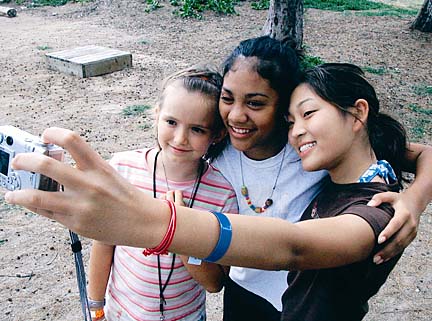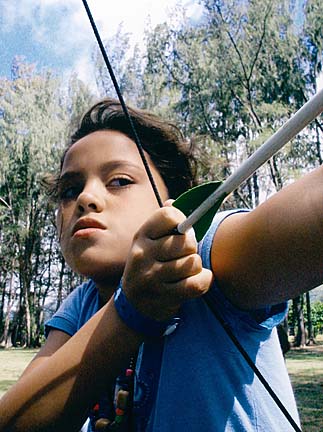
|
Camp celebrates life
Camp Anuenue has given young cancer
patients a memorable respite for 20 years
Camp Anuenue, which gives children with cancer a week of fun and memories, will celebrate its 20th anniversary during this year's event starting today at Camp Mokuleia.
The free summer camp is sponsored annually by the American Cancer Society Hawaii Pacific for children ages 7 to 17.
It started with 24 kids and has grown to about 60. More than 1,000 children from Hawaii, Guam and American Samoa have attended the camp over the years, enjoying sports, arts and crafts and other activities and building friendships and self-esteem.
About 800 former campers, volunteers, staff members, founders and friends have been invited to a reunion Saturday on the last camp day, said Cathi Chun, volunteer reunion director. Her husband, Irving, is volunteer staff director.
She began volunteering at the camp in 1985, the year they lost their 5-year-old daughter to cancer; Irving has been involved about 15 years, she said.
"She (their daughter) never had the joy of camp in her life but it has been a great thing for us," Chun said. "In a way, it brought us a whole new family of children."
With dramatic improvements in treatments in the 1980s and 90s and increased participation in clinical trials, Chun said, "more children were continuing to come and do well and give hope to newly diagnosed children."
When they hold a "memory fireside" at the camp, she said, "Now, there are only one or two to say farewell to."
Chun said it is "such a pleasure" to see children overcome cancer treatment and difficult times with relapses and then move on as successful young adults.

|
"All these things in life you get so taken up with, at camp you get back to basics, what's important. Children teach and reteach you that every single year."
The second year of the "cancer camp," the children voted on a name and chose "Anuenue" (rainbow) because a rainbow is a sign of hope, Chun said.
The first Camp Anuenue director was Linda Roberts, then medical affairs and patient services director of the Cancer Society in Honolulu. She said she saw a video about such a camp while attending a mainland conference.
"I came back to Hawaii and said it's something we have to do here," she recalled. "It's just a phenomenal project, a wonderful thing for children and families. I started to put it together with a lot of wonderful volunteers."
At Kapiolani Medical Center for Women and Children, Dr. Robert Wilkinson, pediatric oncologist, and Carol Kotsubo, clinical nurse specialist for pediatric oncology, also had heard about the camps and went to the Cancer Society. "It just flowed from all of us," Kotsubo said.
Camp Mokuleia, chosen as the site, "then was really a grassroots, barebones camp with a funky little pool and old cabins," Roberts said.
Many physicians and nurses volunteered but the problem was to find counselors to help the kids "have a wonderful time," Roberts said. She asked Camp Mokuleia if its counselors, including many from the mainland, would stay on a week longer for the cancer camp and all signed up, she said.
"They were blown away at what a different experience it was to work with these kids. They had such an amazing spirit."
Besides giving the children a memorable experience and helping them forget about cancer for a week, the camp gives a break to families dealing with their child's illness, Roberts said.
"It really grew and became a fantastic thing over the years. I was delighted to be there for the first camps. They (children) were unique and really wonderful in their spirit," she said.
Kotsubo, who has been to every camp, noted "huge leaps in improvements" in treatments of cancers in children since the 1960s and 1970s.
She said the cure rate for all cancers in children is about 75 percent to 80 percent. "There are many more survivors. They come back as counselors. That's so spectacular. They (newly diagnosed children ) see that 'that can be me. It's pretty awful now, but I will get better and will continue to have a good life.'
"That doesn't mean they won't have problems afterwards because it is pretty rough treatment," she added. "We're all looking at long-term effects much more than we used to. What price did they have to pay to get that cure and how will their life be impacted?"
Dr. Desiree Medeiros, pediatric oncologist and hematologist, said: "I loved it so much. It's just a really great week for these kids. They are able to be normal, to be with other friends who have gone through the same things they have."
Many years ago a diagnosis of cancer for children "basically was a life sentence," she said, describing improvements in the treatments, side effects and quality of life.
Most of the campers are older kids, which shows "they are actually surviving to be teens, to come back and be counselors," she said.
Medeiros said the camp offers "a great perspective" because "it's sad and heartwrenching" to see the kids sick and miserable getting therapy in the hospital.
"But when you go out to camp, you say 'this is why I'm doing it.' You see how well they're doing. They're happy, normal, doing water balloon fights and practical jokes."
|

|
Counselors inspire campers
with personal stories of survival
Cancer survivors Cory Bacon and Ben Weaver give hope to children with cancer by being themselves.Both are former campers at Camp Anuenue, held each summer by the American Cancer Society Hawaii Pacific for children with cancer.
Now they return as volunteer counselors.
Bacon 20, was diagnosed in August 1989 with Rhabdomyo-sarcoma, cancer in the muscles around his bladder, and it spread to his lymph nodes.
His parents, Janet and Roger Bacon of Pukalani, Maui, were told their 4-year-old had a grapefruit-sized tumor in his bladder and had only four days to live.
"He's our miracle child and his survival of childhood cancer story has reached people around the globe," his mother wrote in an e-mail.
Bacon, now living in Huntington Beach, Calif., said his parents had a choice of cutting out the tumor or treating it with chemotherapy and radiation. They chose the latter treatment, which he had until he was about 6 1/2 years old, when the tumor was gone.
"I remember my attitude towards it," he said. "There was no doubt in my mind I was going to live through it. I didn't think I was going to die. (I thought) God's on my side, I'm going to win."
Weaver, 23, who just graduated from Notre Dame with a bachelor's degree in architecture, was diagnosed with Acute Lympocytic Leukemia when he was 4.
He recalls going into a remission, then a relapse and a change of therapy "since traditional methods didn't work."
The Windward Oahu youth attended St. Anthony's School in Kailua where his parents, Michael and Cecelia, were teachers. He only missed school once when he was hospitalized with pneumonia, he said. His mother still teaches at St. Anthony and his father is principal of Damien Memorial High School, from which he graduated.
When he tells children with cancer at camp that he's been cancer-free for 14 years, they're surprised, Weaver said. "They ask where I went to school. They can see you can get on with your life and it doesn't hold you back too much."
Weaver first went to Camp Anuenue in 1990 and has attended every year but one. He was a counselor-in-training in 2000, 2001 and 2002 and has been on staff as a volunteer counselor the past two years.
He said Camp Anuenue "is my favorite week of the entire year." He has a job with a leading urban design firm in Pittsburgh but "lucked out" because it doesn't start until the end of July, he said.
When he had cancer, Weaver said, "The key for me was being able to hang out with other people going through the same things." As a survivor, he said, his role is to show young people with cancer and their parents "there's hope for it. More and more of us are former campers."
Bacon, who was born and raised on Maui, returned Tuesday from California for Camp Anuenue.
He began going to the camp when he was 7 and missed only one year when he went to Mexico on a church mission. "We kind of joke around about it, me and the camp director," he said. "She tells me I'm going to take over her job."
He said kids go to camp "just to have fun and play and hang out with other people that have cancer like them, so everybody kind of understands. They're not made fun of when they're there.
"When I was in kindergarten in school, almost every day I got made fun of because I was bald and smaller than everyone. In camp, everyone is bald and has scars. It's one of those things. Everyone hangs out and forgets what's going on."
Seeing him and his friends, "older guys, hanging out with all these little kids, they're excited," he said. 'It gives them a motive to go on for one year."
Bacon works five days a week at Duke's in Huntington Beach and sings and plays the ukulele there one night a week. "In the long term, I think I want to be an actor like Jim Carrey, out of control, with all these different characters he can play."
E-mail to City Desk
[News] [Business] [Features] [Sports] [Editorial] [Do It Electric!]
[Classified Ads] [Search] [Subscribe] [Info] [Letter to Editor]
[Feedback]
